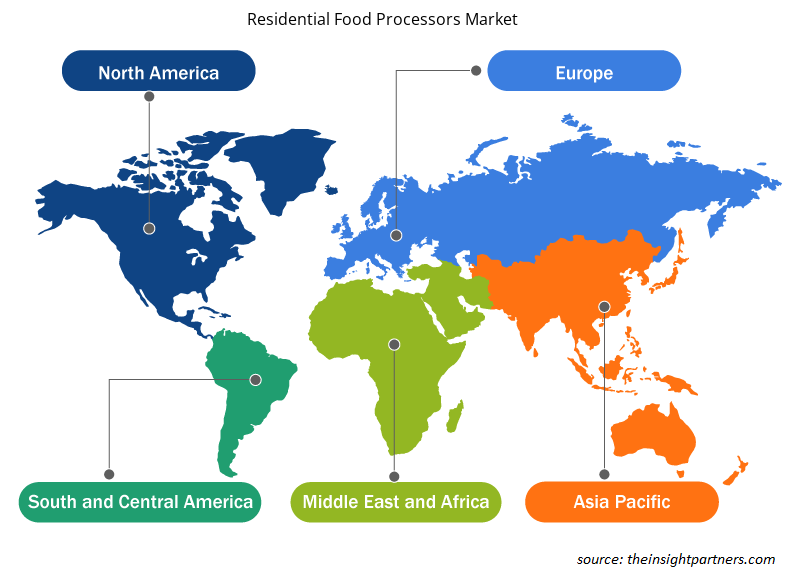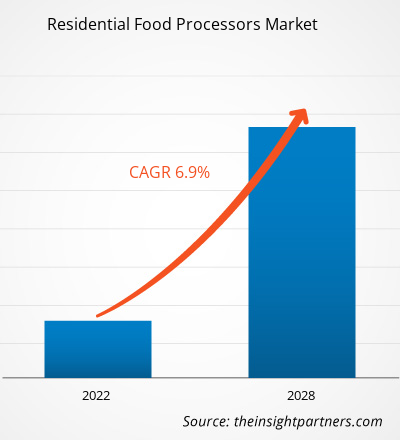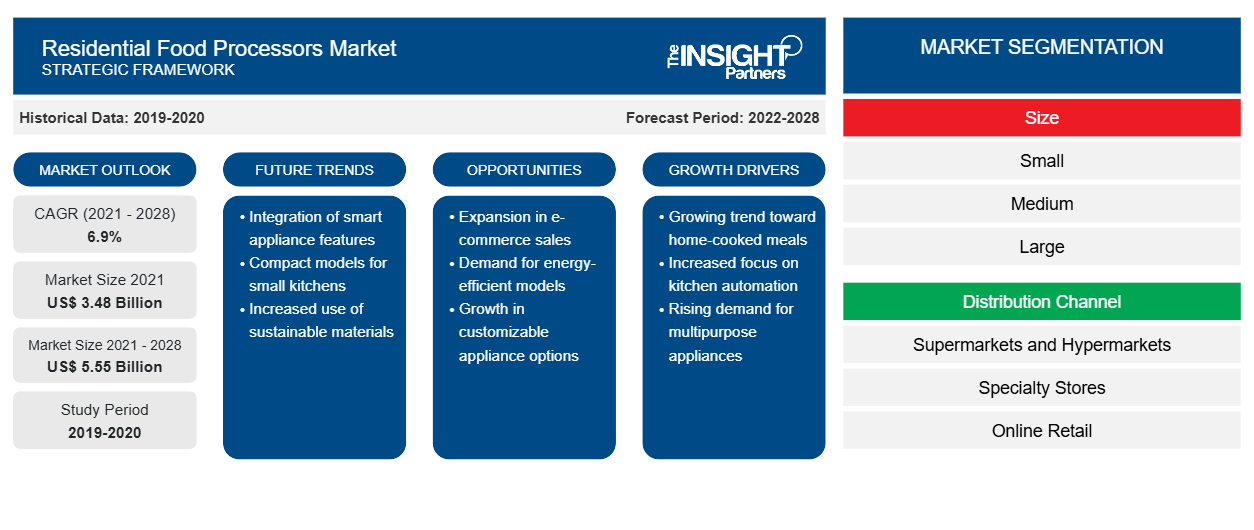El mercado de procesadores de alimentos residenciales se valoró en US$ 3.475,21 millones en 2021 y se proyecta que alcance los US$ 5.553,20 millones en 2028; se espera que crezca a una CAGR del 6,9% de 2021 a 2028.
Un procesador de alimentos doméstico es básicamente un electrodoméstico de cocina que se utiliza para facilitar las tareas repetitivas durante la preparación de alimentos. Los procesadores actuales son en su mayoría automatizados y facilitan la preparación de alimentos.
En 2020, Asia Pacífico dominó el mercado mundial de procesadores de alimentos residenciales y se espera que mantenga su dominio durante el período de pronóstico. El aumento de la población activa en toda la región ha provocado una mayor demanda de electrodomésticos de cocina y domésticos convenientes . Se espera que estos factores impulsen la demanda de procesadores de alimentos residenciales en toda la región. Además, el cambio en los estilos de vida de los consumidores ha llevado a una mayor adopción de electrodomésticos de cocina y domésticos modernizados. El aumento de la población en países como China e India ha provocado un aumento de la construcción de casas y complejos residenciales con espacio de cocina limitado. Por lo tanto, esto conduce a una mayor demanda de pequeños electrodomésticos de cocina, como mini procesadores de alimentos.
Personalice este informe según sus necesidades
Obtendrá personalización en cualquier informe, sin cargo, incluidas partes de este informe o análisis a nivel de país, paquete de datos de Excel, así como también grandes ofertas y descuentos para empresas emergentes y universidades.
-
Obtenga las principales tendencias clave del mercado de este informe.Esta muestra GRATUITA incluirá análisis de datos, desde tendencias del mercado hasta estimaciones y pronósticos.
Perspectivas del mercado
Demanda creciente de productos convenientes
El estilo de vida de los consumidores se ha vuelto frenético en los últimos años debido al aumento de la presión laboral, lo que hace que se sientan agotados después de sus horas laborales habituales. Los profesionales que trabajan prefieren cada vez más electrodomésticos para el hogar y la cocina cómodos, automatizados e inteligentes que puedan ahorrarles tiempo y esfuerzo. Los procesadores de alimentos domésticos son multifuncionales y rápidos. Estos procesadores de alimentos funcionan de manera eficaz y significativa para facilitar el proceso de cocción incluso si un usuario cocina para un gran número de personas.
Información sobre el tamaño
Según el tamaño, el mercado de procesadores de alimentos residenciales se segmenta en pequeño, mediano y grande. En 2020, el segmento mediano dominó el mercado. La mayor restricción del tamaño y el espacio de la cocina en los países en desarrollo es uno de los factores que impulsa la demanda de procesadores de alimentos residenciales de tamaño mediano. El procesador de alimentos residencial mediano incluye un disco rebanador mediano, un disco triturador y una cuchilla picadora de acero inoxidable para procesar.
Entre los actores clave que operan en el mercado de procesadores de alimentos domésticos se encuentran Koninklijke Philips NV, Whirlpool Corporation, Breville Group Limited, De'Longhi Appliances Srl, Conair Corporation, Robert Bosch GmbH, MAGIMIX, SharkNinja Operating LLC, Groupe SEB y Spectrum Brands Inc. Los principales actores adoptan varias estrategias, como fusiones y adquisiciones y lanzamientos de productos, para expandir su presencia geográfica y su base de consumidores. Philips N.V., Whirlpool Corporation, Breville Group Limited, De’Longhi Appliances S.r.l., Conair Corporation, Robert Bosch GmbH, MAGIMIX, SharkNinja Operating LLC, Groupe SEB, and Spectrum Brands Inc. are among the key players operating in the residential food processors market. The leading players adopt several strategies, such as mergers & acquisitions and product launches, to expand their geographic presence and consumer base.
Perspectivas regionales del mercado de procesadores de alimentos residenciales
Los analistas de Insight Partners explicaron en detalle las tendencias y los factores regionales que influyen en el mercado de procesadores de alimentos residenciales durante el período de pronóstico. Esta sección también analiza los segmentos y la geografía del mercado de procesadores de alimentos residenciales en América del Norte, Europa, Asia Pacífico, Medio Oriente y África, y América del Sur y Central.

- Obtenga datos regionales específicos para el mercado de procesadores de alimentos residenciales
Alcance del informe de mercado de procesadores de alimentos residenciales
| Atributo del informe | Detalles |
|---|---|
| Tamaño del mercado en 2021 | US$ 3.48 mil millones |
| Tamaño del mercado en 2028 | 5.550 millones de dólares estadounidenses |
| CAGR global (2021-2028) | 6,9% |
| Datos históricos | 2019-2020 |
| Período de pronóstico | 2022-2028 |
| Segmentos cubiertos |
Por tamaño
|
| Regiones y países cubiertos |
América del norte
|
| Líderes del mercado y perfiles de empresas clave |
|
Densidad de actores del mercado de procesadores de alimentos residenciales: comprensión de su impacto en la dinámica empresarial
El mercado de procesadores de alimentos residenciales está creciendo rápidamente, impulsado por la creciente demanda de los usuarios finales debido a factores como la evolución de las preferencias de los consumidores, los avances tecnológicos y una mayor conciencia de los beneficios del producto. A medida que aumenta la demanda, las empresas amplían sus ofertas, innovan para satisfacer las necesidades de los consumidores y aprovechan las tendencias emergentes, lo que impulsa aún más el crecimiento del mercado.
La densidad de actores del mercado se refiere a la distribución de las empresas o firmas que operan dentro de un mercado o industria en particular. Indica cuántos competidores (actores del mercado) están presentes en un espacio de mercado determinado en relación con su tamaño o valor total de mercado.
Las principales empresas que operan en el mercado de procesadores de alimentos residenciales son:
- Philips NV, la línea Koninklijke
- Corporación Whirlpool
- Grupo Breville Limitado
- Delaware
Descargo de responsabilidad : Las empresas enumeradas anteriormente no están clasificadas en ningún orden particular.

- Obtenga una descripción general de los principales actores clave del mercado de procesadores de alimentos residenciales
Informe Destacado
- Tendencias progresivas en la industria de procesadores de alimentos residenciales para ayudar a los actores a desarrollar estrategias efectivas a largo plazo
- Estrategias de crecimiento empresarial adoptadas por las empresas para asegurar el crecimiento en los mercados desarrollados y en desarrollo
- Análisis cuantitativo del mercado global de procesadores de alimentos residenciales de 2019 a 2028
- Estimación de la demanda de procesadores de alimentos residenciales en diversas industrias
- Análisis PEST para ilustrar la eficacia de los compradores y proveedores que operan en la industria para predecir el crecimiento del mercado
- Desarrollos recientes para comprender el escenario competitivo del mercado y la demanda de los procesadores de alimentos residenciales
- Tendencias y perspectivas del mercado junto con los factores que impulsan y restringen el crecimiento del mercado de procesadores de alimentos residenciales
- Comprensión de las estrategias que sustentan el interés comercial con respecto al crecimiento del mercado global de procesadores de alimentos residenciales, lo que ayuda en el proceso de toma de decisiones.
- Tamaño del mercado de procesadores de alimentos residenciales en varios nodos del mercado
- Descripción detallada y segmentación del mercado global de procesadores de alimentos residenciales, así como su dinámica industrial
- Tamaño del mercado de procesadores de alimentos residenciales en varias regiones con oportunidades de crecimiento prometedoras
El "Análisis del mercado global de procesadores de alimentos residenciales hasta 2028" es un estudio especializado y profundo de la industria de bienes de consumo con un enfoque especial en el análisis de tendencias del mercado global de procesadores de alimentos residenciales. El informe tiene como objetivo proporcionar una descripción general del mercado con una segmentación detallada del mercado. El mercado de procesadores de alimentos residenciales está segmentado en función del tamaño, el canal de distribución y la geografía. Según el tamaño, el mercado se segmenta en pequeño, mediano y grande. Según el canal de distribución, el mercado de procesadores de alimentos residenciales está segmentado en supermercados e hipermercados, tiendas especializadas, venta minorista en línea y otros. Según la geografía, el mercado está segmentado en cinco regiones principales: América del Norte, Europa, Asia Pacífico, Medio Oriente y África, y América del Sur y Central.
Perfiles de empresas
- Philips NV, la línea Koninklijke
- Corporación Whirlpool
- Grupo Breville Limitado
- Electrodomésticos De'Longhi Srl
- Corporación Conair
- Robert Bosch GmbH
- Mezcla mágica
- Sociedad de responsabilidad limitada SharkNinja
- Grupo SEB
- Marcas del espectro inc.
- Análisis histórico (2 años), año base, pronóstico (7 años) con CAGR
- Análisis PEST y FODA
- Tamaño del mercado, valor/volumen: global, regional y nacional
- Industria y panorama competitivo
- Conjunto de datos de Excel
Informes recientes
Informes relacionados
Testimonios
Razón para comprar
- Toma de decisiones informada
- Comprensión de la dinámica del mercado
- Análisis competitivo
- Información sobre clientes
- Pronósticos del mercado
- Mitigación de riesgos
- Planificación estratégica
- Justificación de la inversión
- Identificación de mercados emergentes
- Mejora de las estrategias de marketing
- Impulso de la eficiencia operativa
- Alineación con las tendencias regulatorias























 Obtenga una muestra gratuita para - Mercado de procesadores de alimentos residenciales
Obtenga una muestra gratuita para - Mercado de procesadores de alimentos residenciales